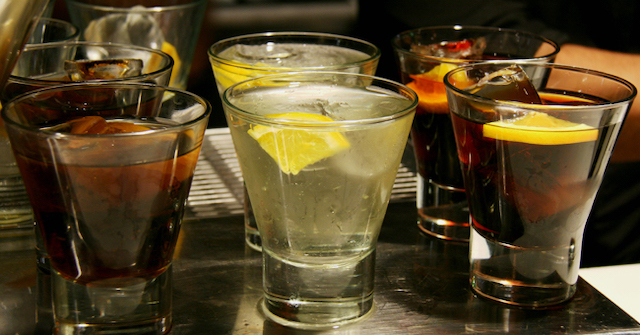Between the spirit industry’s ever-growing obsession with all things bitter, and its newly rekindled fondness for fortified wines, it should come as no surprise that more and more bartenders (and their guests) have turned their eyes to vermouth. The herbaceous aperitif, which was first developed for its curative properties, has long been an essential aspect of cocktail culture: it gives a bitter backbone to classics like the Negroni, the Manhattan and, of course, the martini. Through the lost decades of the ‘70s and ‘80s, vermouth began to gather dust on many a backbar to make room for all those prepackaged sour mixes and grenadines. But now, with a growing number of small craft vermouth brands reimagining the category, alongside larger brands (like Martini Rossi) releasing exciting new styles and collections, vermouth is back in a big way.
As a former brand ambassador for Martini, Giuseppe Gallo has spent years spreading his passion and knowledge of the aromatized wine. We could think of few people more qualified to lead us through vermouth’s rich history and vast range of expressions, so we invited Giuseppe to share some of that know-how. After spending an hour talking (and sipping) all things vermouth, here’s a taste of what we learned.
1. Vermouth is as old as Western medicine itself. Giuseppe tells us it all began with Hippocrates, the father of modern medicine, who found that infusing wine with wormwood aided in digestion. The Greek physician shared his rudimentary vermouth recipe with the Romans, and the rest, as they say, is history. As traveling merchants like Marco Polo began to venture east on the spice trade routes, spices and herbs like saffron, vanilla, and cloves made their way to Venice and beyond (and would ultimately make their way into vermouth as well). A couple of centuries later in 1555, an Italian physician going by the name Alexis of Piedmont penned a manual of curative elixirs, which included dozens of recipes for aromatized wine. Those recipes would ultimately lay the groundwork for what we know as vermouth today.
2. Europe has very specific requirements for vermouth. Producers in the E.U. can’t simply toss a handful of barks and roots into a bottle of wine and call it vermouth. According to law, European-made vermouth must be made with 75% wine, fall between 14.5-21% alcohol by volume and predominantly feature Artemisia absinthium (a.k.a. the wormwood most commonly used in absinthe) among its botanicals. Across the pond in the States, however, things are a little more lax: all that’s needed for your bottle to bear the word “vermouth” is that it tastes and smells like, well, vermouth.
3. Keep it in the fridge, always — and don’t let it sit there. Got a dusty old bottle of vermouth tucked in the pantry next to a stack of spices that’ve been expired since the Clinton presidency? Toss it. Vermouth is meant to be stored in the refrigerator and served chilled — and once it’s been opened, it’s best to consume it within three to four weeks. (Unopened vermouth can remain on the shelf for 18-20 months.) It’s a shorter shelf life than most people presume, but as Giuseppe says, there are 30 days in a month, which gives you 30 opportunities to unwind before dinner with a shot of vermouth. Carpe diem.
4. The range of botanicals is vast (and the possibilities are endless). In our virtual tasting of seven vermouths, ranging from extra-dry to sweet, we picked up everything from florals and citrus to rich, heady tonka bean. Like gin or amari, each vermouth is made with a unique blend of botanicals, so each bottle is different from the next — representing a range both exciting and possibly overwhelming. For bartenders, this means that simply grabbing whichever vermouth bottle is nearest to pour into your Negroni or Manhattan is not the way to go. Rather, Giuseppe recommends spending quality time with the vermouths you have available in order to determine which spirits will best complement it. “The role of bartenders is to know how vermouth is made, know how to play with vermouth in a cocktail, and know how to find the right balance,” he says. “You don’t want to use an overpoweringly sweet vermouth in your Negroni because you want to allow for some bitterness. For your Manhattan, you want a vermouth that will still allow the whiskey to come through with a little bit of tannins at the end.”
5. Prosecco and vermouth are a match made in heaven. While purists like Giuseppe (and many of his Italian brethren) generally take their vermouth over the rocks, perhaps with a splash of tonic, Giuseppe also appreciates his with a slice of orange, lots of ice, and a splash of prosecco. It’s a pared-down riff on the classic Negroni Sbagliato, a drink attributed to a frenzied Italian bartender reaching for a bottle of gin but serendipitously grabbing a bottle of sparkling wine instead. (“Sbagliato” loosely translates to “mistake” in English.) “Prosecco is simple, fruity and crispy,” Giuseppe says. “Vermouth is bitter, herbal, and rich. The combination together is absolutely delicious.”
6. If you want to know more, there’s a lot of reading material. Giuseppe, who says he’s been working, breathing and experiencing vermouth for the last eight years, had several recommendations for anyone interested in furthering their vermouth education.
-
- The Mixellany Guide to Vermouth & Other Aperitifs by Jared Brown and Anistatia Miller
-
- “El Gran Libro del Vermuth” by Francois Monti. Note: this book is in Spanish, but English translation should be coming in 2016.
-
- “Vermouth di Torino” by Arnaldo Strucchi. Published in 1904, it’s the first comprehensive book about vermouth (but you’ll have to brush up on your Italian first).
-
- “Vini di Lusso” by Ottavio Ottavi (also in Italian, and a bit difficult to find due to its rarity)
Thirsting for more? Soak up some of Giuseppe’s knowledge by watching the full virtual tasting below.





